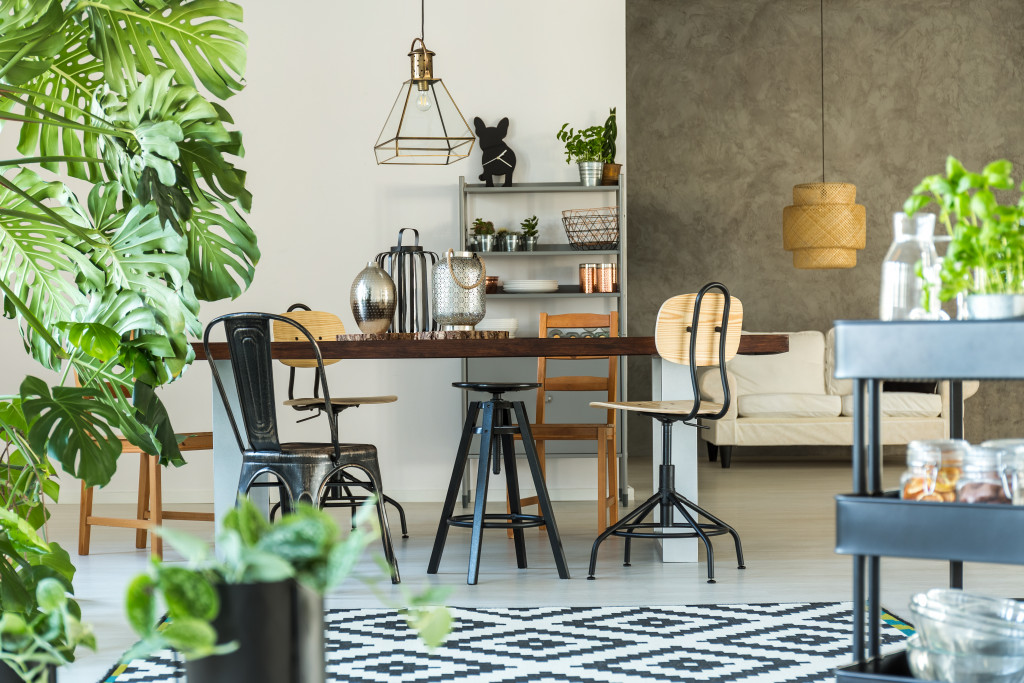- Industrial design is a versatile style that combines raw, exposed elements with refined touches to create chic, welcoming spaces.
- Key components of this aesthetic include exposed structural elements, metal fixtures, neutral colors, and minimalist furniture that merges wood and metal.
- A balance of raw and refined elements is crucial to prevent the space from feeling overly cold or unrefined.
- Industrial design is not just a visual appeal but tells a story about its origin and purpose, adding depth and intrigue to the overall design.
Welcome to the world of interior design, where creativity and functionality intersect. As you embark on this journey of transforming spaces, you’ll soon discover the versatility of industrial style. This aesthetic, characterized by exposed bricks, raw finishes, and a neutral color palette, isn’t just for lofts or warehouses anymore; it can add character and sophistication to any space. Explore some inspirations that will help you harness its remarkable potential.
Evaluate Your Space
Before diving into the industrial aesthetic, it’s crucial to evaluate your space. Consider the architectural elements, room size, lighting, and the room’s purpose. High ceilings, large windows, and open floor plans lend themselves well to industrial design, but don’t be discouraged if your space lacks these features. Industrial design is flexible and can work in smaller or more traditional spaces, too.
Lighting is an essential element; natural light enhances the raw, minimalist feel of the industrial style, but strategically placed artificial lighting can also create the desired effect. Remember that the room’s use should guide the design: a living room might benefit from a softer take on industrial design, while a home office or kitchen could lean into the more rugged aspects.
Research on the Industrial Style
Dive into the history and key elements of the industrial design aesthetic to understand how it can transform your space. Here are some things to consider:
Choose Neutral Colors

The industrial style palette typically revolves around neutral colors, particularly shades of grey, brown, black, and white. These colors align with natural elements like brick, metal, and wood, often left exposed in industrial design. Using neutral colors lends an understated elegance to the space and allows the architectural elements to take center stage.
However, a pop of color can also be incorporated to add visual interest or define specific areas within the space. For instance, a vibrant artwork or a brightly colored furniture item can serve as a focal point and break the monotony of neutral hues. Remember, balance is key in industrial design; it’s all about combining rawness and refinement to create a space that feels both welcoming and chic.
Expose Structural Elements
In industrial design, structural elements are often exposed, contributing to the character and authenticity of the space. This could mean showcasing the building’s original brickwork, displaying ductwork, or leaving beams, columns, and concrete floors uncovered. The idea is to celebrate, not hide, these architectural elements, allowing them to define the space and tell a story about its history.
This bare-bones approach also reinforces the practicality and no-frills attitude characteristic of the industrial style. However, it’s important to maintain a balance and not let the rawness overwhelm the space. Mixing these industrial elements with softer furnishings, lush plants, or warm lighting can create a pleasing contrast and make the space more inviting.
Remember that while the industrial style embraces the imperfect and unfinished, it doesn’t mean the space should feel cold and uninviting. The goal is to create a stylish, functional space that marries the old with the new, the rough with the refined.
Incorporate Metal Elements
Incorporating metal elements is a distinctive aspect of industrial design. These elements can take various forms such as metal light fixtures, furniture, or even decorative items. Metal is a material that brings a sense of sturdiness and durability to the space, reinforcing the raw, industrial feel.
However, it’s important to utilize a high-quality metal marking solution when working with these metal elements. This helps to ensure that any necessary labels, instructions, or decorative markings are clear, durable, and resistant to wear and tear.
Especially in environments where the metal may be exposed to harsh conditions such as heat, moisture, or heavy use, a high-quality metal marking solution can maintain the clarity and longevity of the markings. By incorporating metal elements wisely and ensuring their longevity through appropriate marking solutions, you enhance the industrial aesthetic while ensuring functionality and durability.
Select Industrial-Style Furniture and Accessories
When selecting furniture for an industrial-style space, think utility and simplicity. Industrial furniture often exhibits a fusion of wood and metal, as seen in items like reclaimed wood tables with metal bases or industrial-style shelving units. Seek out pieces with a minimalist design but a sturdy build, clean lines and no unnecessary frills.
As for accessories, consider utilizing items that reflect a sense of history or industrial functionality, such as vintage clocks, factory lamps, or old machinery parts turned into unique décor items. Remember, in industrial design, each piece doesn’t just add to the visual appeal, but also tells a story about its origin and purpose. This can add depth and intrigue to your overall design.
Use Industrial Lighting

Lighting plays a crucial role in industrial design, contributing significantly to the overall ambiance of the space. In traditional industrial settings, lighting fixtures were functional and straightforward, and this principle remains at the heart of the industrial aesthetic. Pendant lights, exposed bulb fixtures, and metal task lamps are all excellent choices for an industrial-style space.
Materials such as copper, brass, or iron lend an authentic feel, while the warm glow from Edison-style bulbs can add a touch of warmth to the raw industrial edges. It’s also an opportunity to make a statement; an oversized pendant or a cluster of bulbs at different heights can be a striking focal point in a room. Remember, the goal of industrial lighting is not just to illuminate the space but also to enhance the architectural elements and contribute to the overall design narrative.
In conclusion, your opportunity to create a unique, dynamic space with industrial design is limitless. Remember to balance raw elements with refined touches to craft a space that’s both chic and welcoming. Now, go forth and transform your space, and let your creativity shine in every corner.




